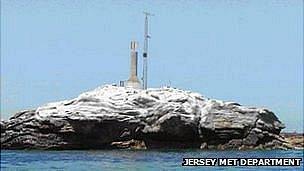Jersey wind power mast plan resubmitted
- Published

Jersey Met has released impressions of the masts along with the plans
Plans to test the wind power off Jersey have been changed to reflect islanders' concerns, the Met Department says.
It has applied for permission to put a mast and weather monitoring equipment on outlying rocks off the islands of the Ecrehous and Minquiers.
Anthony Pallot, principal meteorological officer, said the location was chosen with great care.
He said they needed to balance the concerns with cost and practicalities.
The data will be used to inform discussions about harnessing wind energy and for forecasting the weather.
Mr Pallot said: "I hope people will agree that we've tried to take account of all the issues raised."
He said: "This is an important project that will provide us with accurate, up-to-date information about the very specific weather conditions in this part of Jersey and which is essential to long term planning for Jersey's future energy needs."

Jersey Met said the masts would not be installed when the work would disturb nesting birds
The plans were originally released last year, but were put on hold after people who use the reefs raised concerns about the impact on wildlife and the environment and raised concerns about the project's impact on the reefs and surrounding waters.
A Jersey Met spokesman said it had considered alternatives to the current proposal including a mast designed like a flagpole to cut visual impact and a marine buoy mounted system to minimise changes to land, but neither was suitable for financial or practical reasons.
He said if the plans went ahead they would help to protect bird colonies on the reefs, in line with advice offered by bird experts at the Societe Jersiaise.
The spokesman said the 10m (33ft) mast and weather monitoring equipment would not be put in place during the bird nesting season and the mast would be erected without the usual supporting guy lines which can pose a risk to flying birds.
The masts are expected to be in place for three years.
- Published29 September 2012
- Published11 June 2012